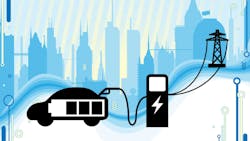V2G Beckons for EV Future But Challenges Persist
Members can download this article in PDF format.
What you’ll learn:
- The opportunities and challenges of bidirectional EV-grid connections (V2G).
- The opportunities that V2G provides to the grid and to automakers and users.
- Emerging standards that can smooth the way, and where to get more information.
Vehicle-to-grid (V2G) is and has been a goal for those looking at the long-term future of electric vehicles and those aiming to maximize system-wide resiliency and efficiency. To date, V2G has only rarely been attempted, usually in the form of the more limited vehicle-to-home (V2H) implementations.
But the whole concept got a boost recently when something called Powershare appeared on the Tesla website along with the long-awaited rollout of CyberTruck. For home backup purposes (V2H), Powershare offers maximum continuous 11.5 kW at a nominal 240 V AC, certainly an impressive capability.
But making V2G a widespread reality requires additional developments on both the grid and vehicle sides.
The Grid and Renewable Energy—Making it Work
For grid operators, most forms of renewable power are relatively or even extremely variable in their output. Simply visualize a cloud bank suddenly drifting across a large solar array and you get the picture.
Tools providing stored energy that can smooth out the peaks and valleys are obviously a necessity if the grid is to survive, and the battery capacity of millions of EVs is an obvious place to look. Enthusiasts for the concept envision vehicles aggregated into virtual powerplants and automatically playing a role in load balancing and even providing emergency power.
Certainly, sophisticated software and instrumentation, if not actual AI/ML, will be needed to assess the state of the grid and the state of the unique and widely scattered vehicle battery packs to make this feasible. Of course, it’s a challenging prospect.
V2G has two main technical aspects, namely the challenges in the vehicle and the challenges outside of the vehicle. Both are subject to broad impacts of consumer preferences, economic factors, the state of existing infrastructure, and policy decisions that may come as a more electrified world comes into existence.
The impact of V2G on battery systems is one of the first considerations, because that in turn influences vehicle range as well as the health and longevity of battery systems including state of charge (SOC) and depth of discharge (DOD). Vehicle owners will want to ensure that V2G doesn’t leave them less than fully charged when they need to use their vehicle and that it doesn’t damage to battery life—a real possibility given the general correlation between discharge cycles and battery life.
On the other hand, some research suggests that V2G could actually become part of healthy-cycling practices contributing to longer battery life. It’s an area long on theories but short on clear best practices so far.
Aggregating the storage resources of many vehicles and managing them in some kind of group seems likely to be a path forward. These groupings might be random, geographical, or even based on detected use patterns.
In that last case, drivers who are generally home and off the road by late afternoon and out on the highway very early could be relied on to have achieved a state of full charge by, say, midnight. In turn, they could offer up capacity for a few hours before “topping off” in preparation for a morning commute.
This implies a considerable gathering and sharing of SOC information and “lifestyle” information so that reasonable usage patterns can be inferred. The knowledge sharing can also help mediate charging of individual vehicles as well as demand management across the network to ensure the most efficient use and sharing of power.
None of these things are trivial tasks, but they’re more doable with AI/ML. And the reward can be greater grid stability, and perhaps reduced battery degradation as well as greater affordability for EV owners.
Better EVSE Electrical Efficiency
The overall efficiency of bidirectional energy transmission, particularly from the electric-vehicle supply equipment (EVSE), is another obvious area where technology can be tweaked. The National Electronics Manufacturers Association (NEMA) says that “EVSE systems include the electrical conductors, related equipment, software, and communications protocols that deliver energy efficiently and safely to the vehicle.” In other words, given the large loads involved and the important consequences on the supply infrastructure and the vehicle, a system view of charging is vital to achieve good results.
V2G systems can be very efficient but failure to view the full system’s picture can produce disappointment and energy losses anywhere in the V2G system, influencing efficiency and ultimate cost-effectiveness. From the individual batteries in the pack to the power electronic unit (PEU) in the vehicles to the connectors, cable, and voltage and current converters, there are losses to be considered and if possible avoided.
Researchers have found typical losses are high at the power electronics unit (PEU) and the transformer, with the most variability in the latter. But PEU problems stem especially from having to deliver power through a wide range of currents and voltages, complicating any efforts to maximize efficiency.
Nor can environmental factors be omitted, since battery systems generally fare poorly at lower temperatures, with system-wide implications. Indeed, some lithium-ion cells are very difficult to charge at all below 0°C.
V2G Communications and Intelligence
Software and science can help, of course, through the development and/or implementation of algorithms that can work toward an optimal balance of performance and efficiency under every demand scenario.
Communication among and between vehicles, homes, charging stations, and utilities is likely to be crucial to V2G success. However, as of now, standards are lacking that can both ensure privacy and security and move required data successfully.
Among those standards currently in play or under consideration are the International Organization for Standardization (ISO) 15118; the Society of Automotive Engineers (SAE) J2847 and SAE J17722,3 standard or its dc-capable variant, the Combined Charging System; and CHAdeMO, an emerging standard originating in Japan.
ISO 15118 aims to control charging in AC, DC, and V2G scenarios. It considers protocol requirements, the need for physical and data link layers, and wireless communication. CHAdeMO is primarily a DC charging standard for electric vehicles, but it also supports communication between the car and the charger.
Other relevant standards include ISO 61850 and Open Charge Point Protocol (OCPP). No doubt, there may well be a role for the familiar Controller Area Network (CAN) bus, too.
As implied earlier, the very nature of EVs—highly mobile without fixed use patterns—will make any communication structure and its implementation challenging. It will require high bandwidth to maintain awareness of a system-wide state of charge and even more gymnastics to ensure ongoing SOC that meets the need of the vehicle owner/operator. The broad need for serious security is achievable but adds considerable additional operational complexity.
Nonetheless, the enormous storage capacity of road vehicles will remain a tempting target for integration into the grid.
References
About the Author


